Equilibrium, Kinetic and Thermodynamic Studies for Sorption of Phosphate from Aqueous Solutions Using ZnO Nanoparticles
Abstract
1. Introduction
2. Materials and Methods
2.1. Preparation of Materials
2.2. Characterization
2.3. Assessment of the Prepared ZnO Nanopowder for Phosphorus Decontamination
2.4. Adsorption Capacity of the
2.5. Equilibrium and Kinetic Modeling of the Phosphorus Decontamination Process onto ZnO
3. Results and Discussion
3.1. Factors Affecting the Morphology and Surface Structure of ZnO Nanoparticles
3.1.1. SEM Image Analysis
3.1.2. Determination of Surface Area by the BET Method
3.2. Structure and Morphology
3.2.1. XRD Analysis
3.2.2. EDS Analysis
3.2.3. Particle-Size Distribution by Laser Diffraction
3.3. Determination of the Isoelectric Point of ZnO
3.4. Adsorption of Phosphate by ZnO Nanoparticles
3.4.1. Effect of pH
3.4.2. Effect of Contact Time
3.4.3. Effect of ZnO Dosage
3.4.4. Effect of Temperature
3.5. Adsorption Isotherm
3.5.1. Langmuir Isothermal Adsorption Model
3.5.2. Freundlich Isothermal Adsorption Model
3.5.3. Dubinin–Radushkevich Isothermal Adsorption Model
- q: adsorption volume (mg/g);
- qmax: maximum adsorption volume (mg/g);
- β: constant of the adsorption energy (mol2/J2);
- ε: Polanyi, described as follows:where:
- T: solution temperature (K);
- R: gas constant (8.314 × 10−3 kJ/mol.K).
3.5.4. Tempkin Isothermal Adsorption Model
- T: is the absolute temperature (K);
- R: gas constant (valued by 8.314 × 10−3 (kJ/mol.K);
- bT: Tempkin constant (kJ/mol).
3.6. Study on the Adsorption Kinetics of on ZnO Nanomaterials
3.7. Thermal Dynamic of Adbsorption of onto ZnO Nanomaterials
- KD: equilibrium constant;
- qe: adsorption volume at equilibrium (mg/g);
- Ccb: concentration of the substrate at equilibrium (mg/L);
- R: gas constant;
- T: temperature (K).
4. Conclusions
Author Contributions
Funding
Conflicts of Interest
References
- Lee, S.-C.; Park, H.-H.; Kim, S.-H.; Koh, S.-H.; Han, S.-H.; Yoon, M.-Y. Ultrasensitive Fluorescence Detection of Alzheimer’s Disease Based on Polyvalent Directed Peptide Polymer Coupled to a Nanoporous ZnO Nanoplatform. Anal. Chem. 2019, 91, 5573–5581. [Google Scholar] [CrossRef] [PubMed]
- Zhou, T.; Hu, M.; He, J.; Xie, R.; An, C.; Li, C.; Luo, J. Enhanced catalytic performance of zinc oxide nanorods with crystal plane control. CrystEngComm 2019, 21, 5526–5532. [Google Scholar] [CrossRef]
- Chen, W.; Han, J.; Yi, J. Nanostructured SnO2- and ZnO-Based Gas Sensors for Early Warning of Electrical Fires. Meet. Abstr. 2020, MA2020-01, 2176. [Google Scholar] [CrossRef]
- Chao, J.; Chen, Y.; Xing, S.; Zhang, D.; Shen, W. Facile fabrication of ZnO/C nanoporous fibers and ZnO hollow spheres for high performance gas sensor. Sens. Actuators B Chem. 2019, 298, 126927. [Google Scholar] [CrossRef]
- ZnO-based nanostructured electrodes for electrochemical sensors and biosensors in biomedical applications. Biosens. Bioelectron. 2019, 141, 111417. [CrossRef]
- Kim, J.Y.; Vincent, P.; Jang, J.; Jang, M.S.; Choi, M.; Bae, J.-H.; Lee, C.; Kim, H. Versatile use of ZnO interlayer in hybrid solar cells for self-powered near infra-red photo-detecting application. J. Alloy. Compd. 2020, 813, 152202. [Google Scholar] [CrossRef]
- Minami, T.; Nanto, H.; Takata, S. Highly Conductive and Transparent Aluminum Doped Zinc Oxide Thin Films Prepared by RF Magnetron Sputtering. Jpn. J. Appl. Phys. 1984, 23, L280–L282. [Google Scholar] [CrossRef]
- Demirci, S.; Dikici, T.; Tünçay, M.M.; Kaya, N. A study of heating rate effect on the photocatalytic performances of ZnO powders prepared by sol-gel route: Their kinetic and thermodynamic studies. Appl. Surf. Sci. 2020, 507, 145083. [Google Scholar] [CrossRef]
- Thambidurai, S.; Gowthaman, P.; Venkatachalam, M.; Suresh, S. Natural sunlight assisted photocatalytic degradation of methylene blue by spherical zinc oxide nanoparticles prepared by facile chemical co-precipitation method. Optik 2020, 207, 163865. [Google Scholar] [CrossRef]
- Irshad, K.; Khan, M.T.; Murtaza, A. Synthesis and characterization of transition-metals-doped ZnO nanoparticles by sol-gel auto-combustion method. Phys. B: Condens. Matter 2018, 543, 1–6. [Google Scholar] [CrossRef]
- Thakur, S.; Mandal, S.K. Effect of dilution in a hydrothermal process and post-synthetic annealing on the tailoring of hierarchical ZnO nanostructures. CrystEngComm 2020, 22, 3059–3069. [Google Scholar] [CrossRef]
- Shokry Hassan, H.; Kashyout, A.B.; Morsi, I.; Nasser, A.A.A.; Raafat, A. Fabrication and characterization of gas sensor micro-arrays. Sens. Bio-Sens. Res. 2014, 1, 34–40. [Google Scholar] [CrossRef]
- F Elkady, M.; Shokry Hassan, H. Equilibrium and dynamic profiles of azo dye sorption onto innovative nano-zinc oxide biocomposite. Curr. Nanosci. 2015, 11, 805–814. [Google Scholar] [CrossRef]
- Rizzi, V.; D’Agostino, F.; Gubitosa, J.; Fini, P.; Petrella, A.; Agostiano, A.; Semeraro, P.; Cosma, P. An Alternative Use of Olive Pomace as a Wide-Ranging Bioremediation Strategy to Adsorb and Recover Disperse Orange and Disperse Red Industrial Dyes from Wastewater. Separations 2017, 4, 29. [Google Scholar] [CrossRef]
- Li, N.; Tian, Y.; Zhao, J.; Zhan, W.; Du, J.; Kong, L.; Zhang, J.; Zuo, W. Ultrafast selective capture of phosphorus from sewage by 3D Fe3O4@ZnO via weak magnetic field enhanced adsorption. Chem. Eng. J. 2018, 341, 289–297. [Google Scholar] [CrossRef]
- Nakarmi, A.; Bourdo, S.E.; Ruhl, L.; Kanel, S.; Nadagouda, M.; Kumar Alla, P.; Pavel, I.; Viswanathan, T. Benign zinc oxide betaine-modified biochar nanocomposites for phosphate removal from aqueous solutions. J. Environ. Manag. 2020, 272, 111048. [Google Scholar] [CrossRef]
- Liu, Z.; Lu, Y.; Li, X.; Chen, H.; Hu, F. Adsorption of phosphate from wastewater by a ZnO-ZnAl hydrotalcite. Int. J. Environ. Anal. Chem. 2019, 99, 1415–1433. [Google Scholar] [CrossRef]
- Laliberté, G.; Lessard, P.; de la Noüe, J.; Sylvestre, S. Effect of phosphorus addition on nutrient removal from wastewater with the cyanobacterium Phormidium bohneri. Bioresour. Technol. 1997, 59, 227–233. [Google Scholar] [CrossRef]
- Li, M.; Liu, J.; Xu, Y.; Qian, G. Phosphate adsorption on metal oxides and metal hydroxides: A comparative review. Environ. Rev. 2016, 24, 319–332. [Google Scholar] [CrossRef]
- Lalley, J.; Han, C.; Li, X.; Dionysiou, D.D.; Nadagouda, M.N. Phosphate adsorption using modified iron oxide-based sorbents in lake water: Kinetics, equilibrium, and column tests. Chem. Eng. J. 2016, 284, 1386–1396. [Google Scholar] [CrossRef]
- Almeelbi, T.; Bezbaruah, A. Aqueous phosphate removal using nanoscale zero-valent iron. In Proceedings of the Nanotechnology for Sustainable Development; Diallo, M.S., Fromer, N.A., Jhon, M.S., Eds.; Springer International Publishing: Cham, Switzerland, 2014; pp. 197–210. [Google Scholar]
- Tu, Y.-J.; You, C.-F.; Chang, C.-K.; Chen, M.-H. Application of magnetic nano-particles for phosphorus removal/recovery in aqueous solution. J. Taiwan Inst. Chem. Eng. 2015, 46, 148–154. [Google Scholar] [CrossRef]
- Akyol, A.; Yatmaz, H.C.; Bayramoglu, M. Photocatalytic decolorization of Remazol Red RR in aqueous ZnO suspensions. Appl. Catal. B Environ. 2004, 54, 19–24. [Google Scholar] [CrossRef]
- Mohd Omar, F.; Abdul Aziz, H.; Stoll, S. Aggregation and disaggregation of ZnO nanoparticles: Influence of pH and adsorption of Suwannee River humic acid. Sci. Total Environ. 2014, 468–469, 195–201. [Google Scholar] [CrossRef]
- Elkady, M.F.; Shokry Hassan, H.; Salama, E. Sorption Profile of Phosphorus Ions onto ZnO Nanorods Synthesized via Sonic Technique. J. Eng. 2016, 2016, 1–9. [Google Scholar] [CrossRef]
- Elkady, M.F.; El-Sayed, E.M.; Farag, H.A.; Zaatout, A.A. Assessment of Novel Synthetized Nanozirconium Tungstovanadate as Cation Exchanger for Lead Ion Decontamination. J. Nanomater. 2014, 2014, 1–11. [Google Scholar] [CrossRef]
- Luo, Z.; Zhu, S.; Liu, Z.; Liu, J.; Huo, M.; Yang, W. Study of phosphate removal from aqueous solution by zinc oxide. J. Water Health 2015, 13, 704–713. [Google Scholar] [CrossRef]
- Zhou, J.; Yang, S.; Yu, J.; Shu, Z. Novel hollow microspheres of hierarchical zinc–aluminum layered double hydroxides and their enhanced adsorption capacity for phosphate in water. J. Hazard. Mater. 2011, 192, 1114–1121. [Google Scholar] [CrossRef]
- Mahdavi, S.; Hassani, A.; Merrikhpour, H. Aqueous phosphorous adsorption onto SnO2 and WO3 nanoparticles in batch mode: Kinetic, isotherm and thermodynamic study. J. Exp. Nanosci. 2020, 15, 242–265. [Google Scholar] [CrossRef]
- Li, G.; Gao, S.; Zhang, G.; Zhang, X. Enhanced adsorption of phosphate from aqueous solution by nanostructured iron(III)–copper(II) binary oxides. Chem. Eng. J. 2014, 235, 124–131. [Google Scholar] [CrossRef]
- Trinh, V.T.; Nguyen, T.M.P.; Van, H.T.; Hoang, L.P.; Nguyen, T.V.; Ha, L.T.; Vu, X.H.; Pham, T.T.; Nguyen, T.N.; Quang, N.V.; et al. Phosphate Adsorption by Silver Nanoparticles-Loaded Activated Carbon derived from Tea Residue. Sci. Rep. 2020, 10, 1–13. [Google Scholar] [CrossRef]
- Shahid, M.K.; Kim, Y.; Choi, Y.-G. Adsorption of phosphate on magnetite-enriched particles (MEP) separated from the mill scale. Front. Environ. Sci. Eng. 2019, 13, 71. [Google Scholar] [CrossRef]
- Xiong, L.; Yang, Y.; Mai, J.; Sun, W.; Zhang, C.; Wei, D.; Chen, Q.; Ni, J. Adsorption behavior of methylene blue onto titanate nanotubes. Chem. Eng. J. 2010, 156, 313–320. [Google Scholar] [CrossRef]
- Plaza Cazón, J.; Bernardelli, C.; Viera, M.; Donati, E.; Guibal, E. Zinc and cadmium biosorption by untreated and calcium-treated Macrocystis pyrifera in a batch system. Bioresour. Technol. 2012, 116, 195–203. [Google Scholar] [CrossRef] [PubMed]
- Ajaelu, C.J.; Nwosu, V.; Ibironke, L.; Adeleye, A. Adsorptive removal of cationic dye from aqueous solution using chemically modified African Border Tree (Newbouldia laevis) bark. J. Appl. Sci. Environ. Manag. 2017, 21, 1323–1329. [Google Scholar] [CrossRef][Green Version]
- Zhu, N.; Yan, T.; Qiao, J.; Cao, H. Adsorption of arsenic, phosphorus and chromium by bismuth impregnated biochar: Adsorption mechanism and depleted adsorbent utilization. Chemosphere 2016, 164, 32–40. [Google Scholar] [CrossRef]
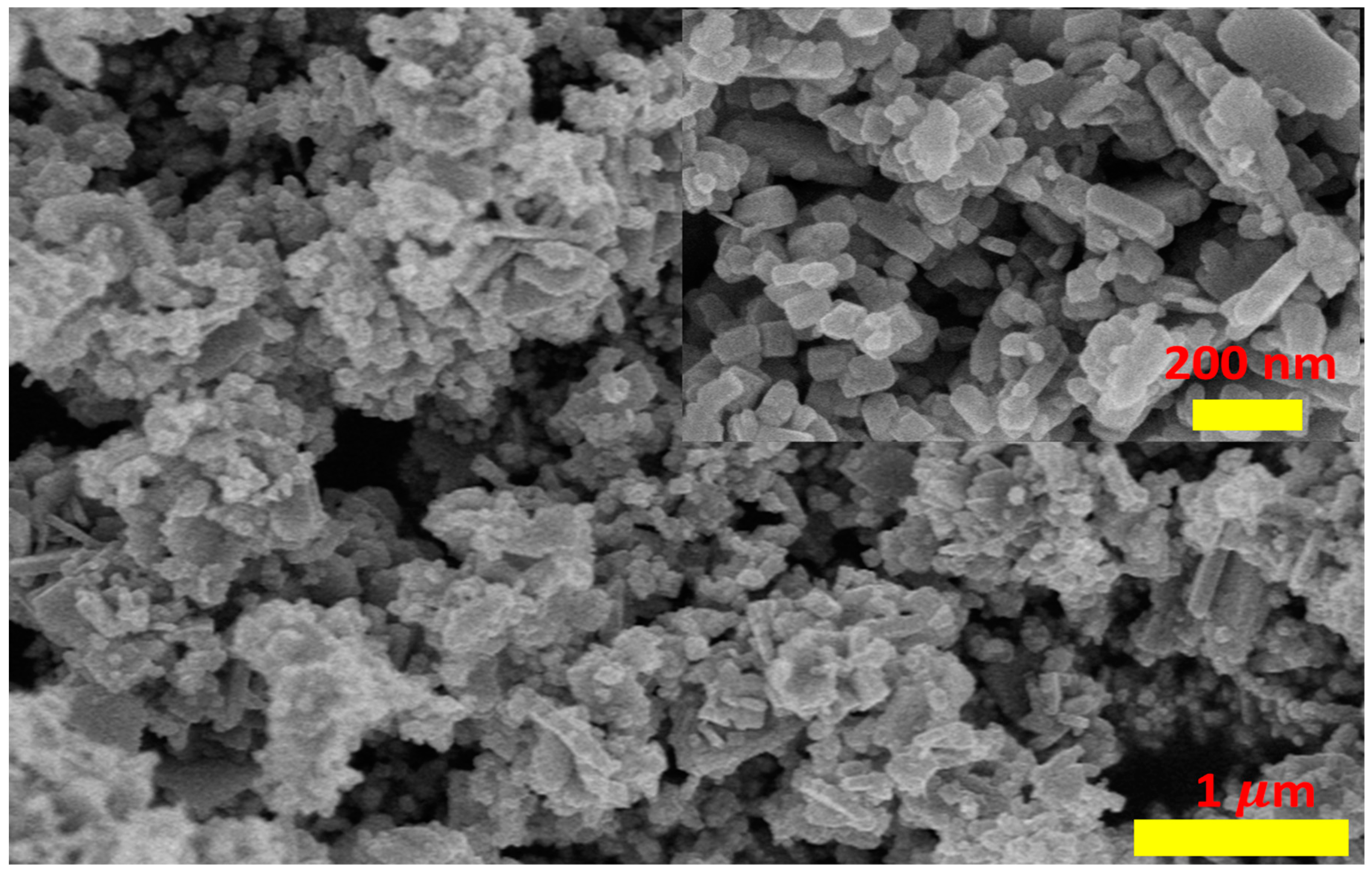

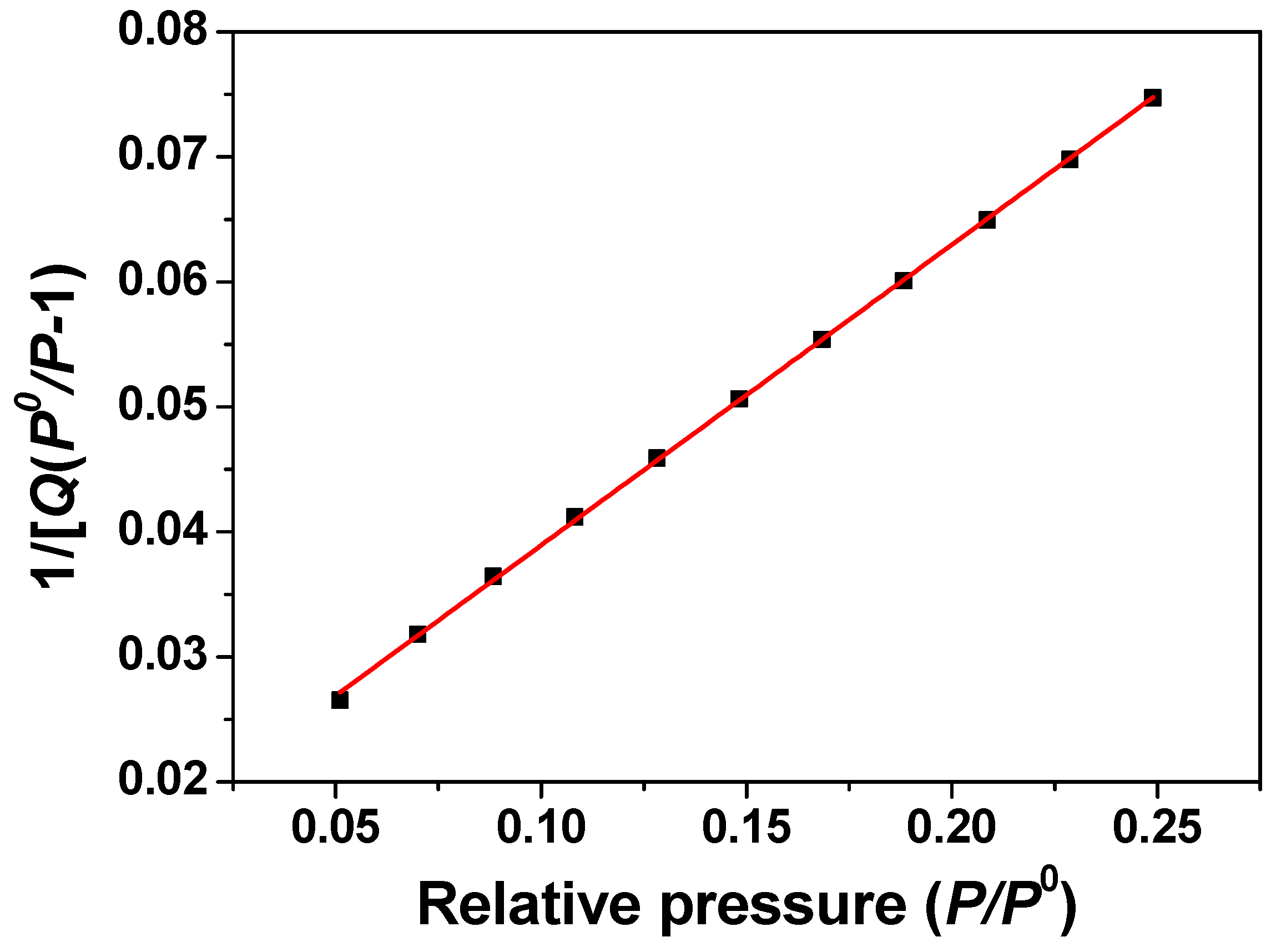

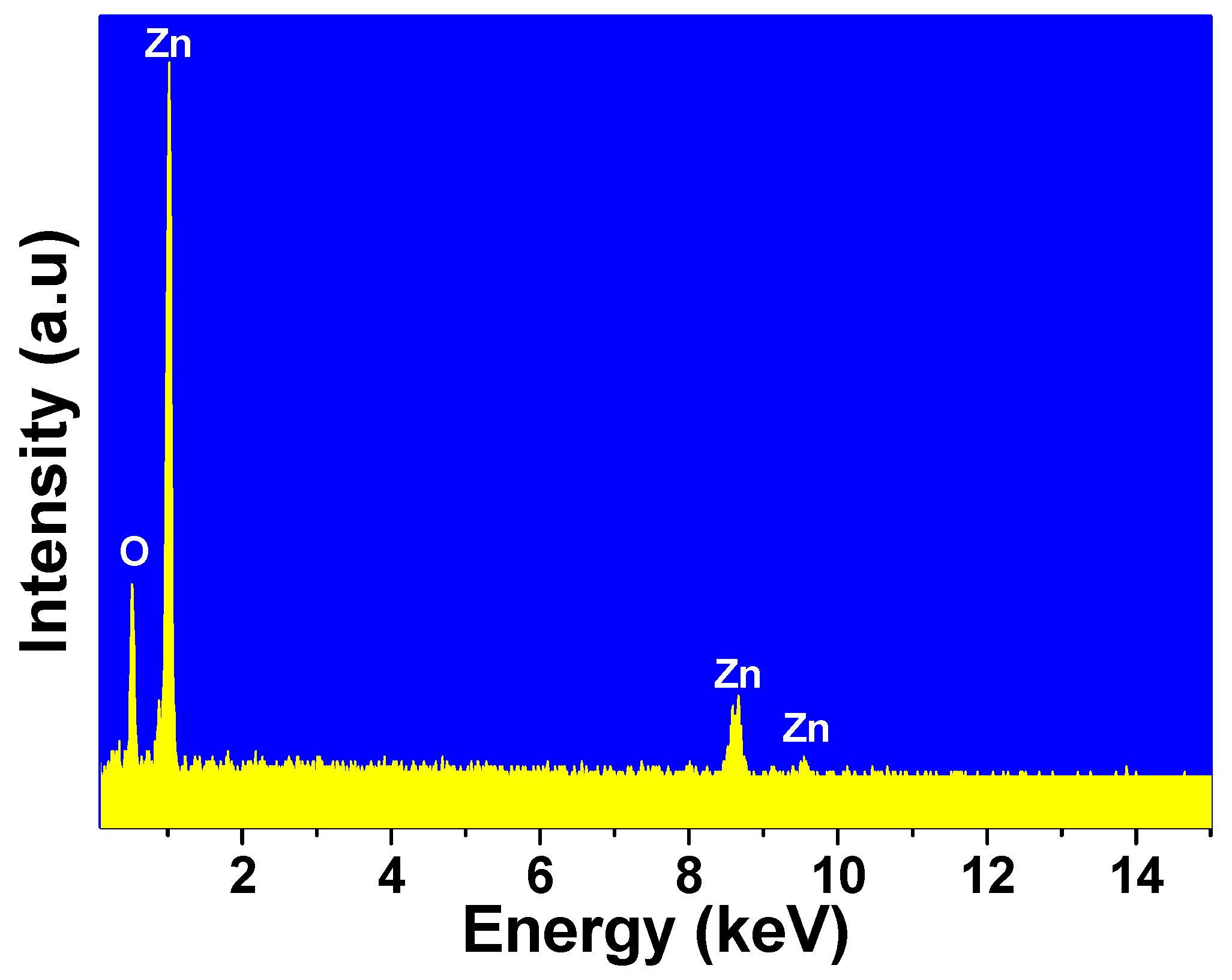
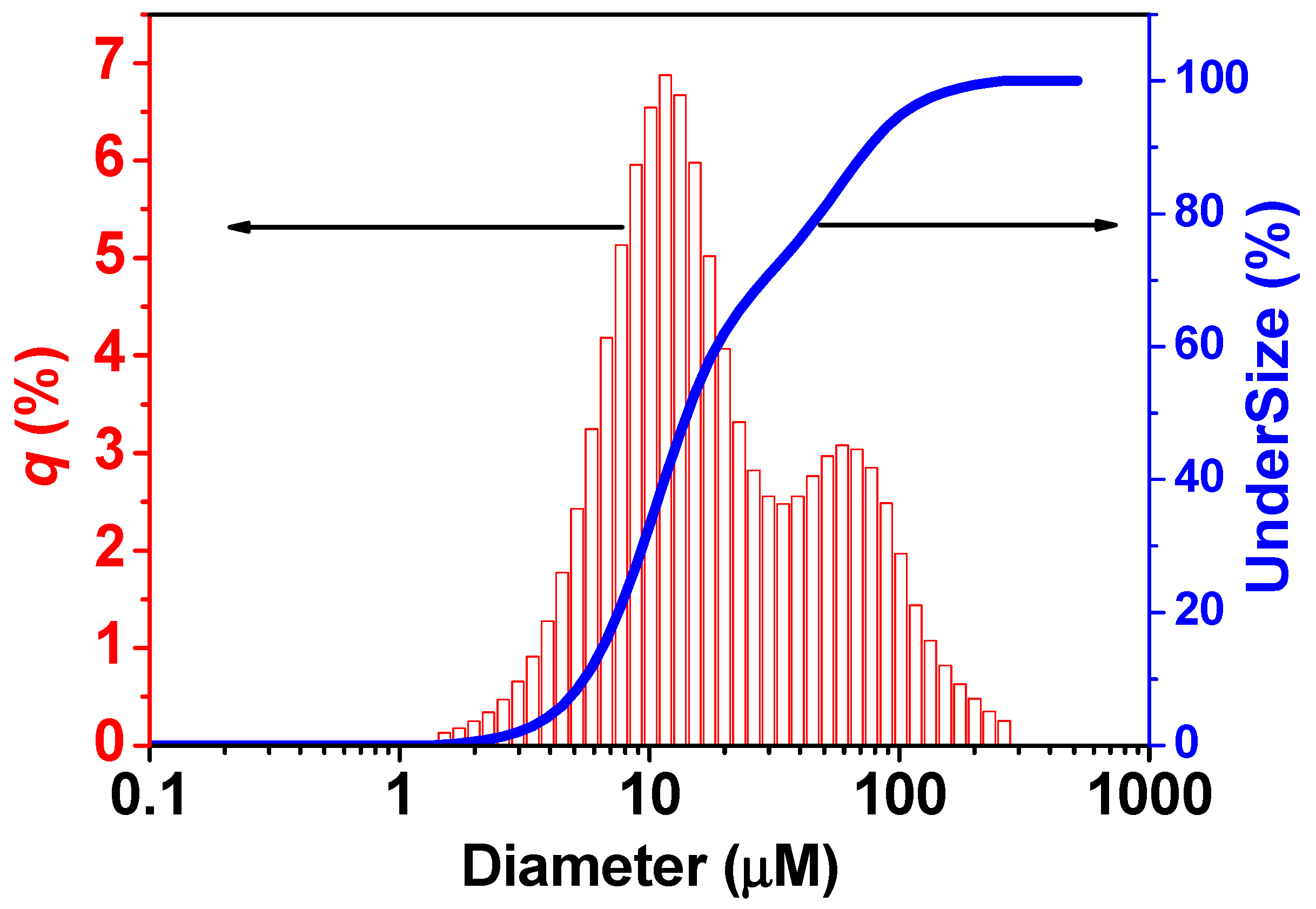

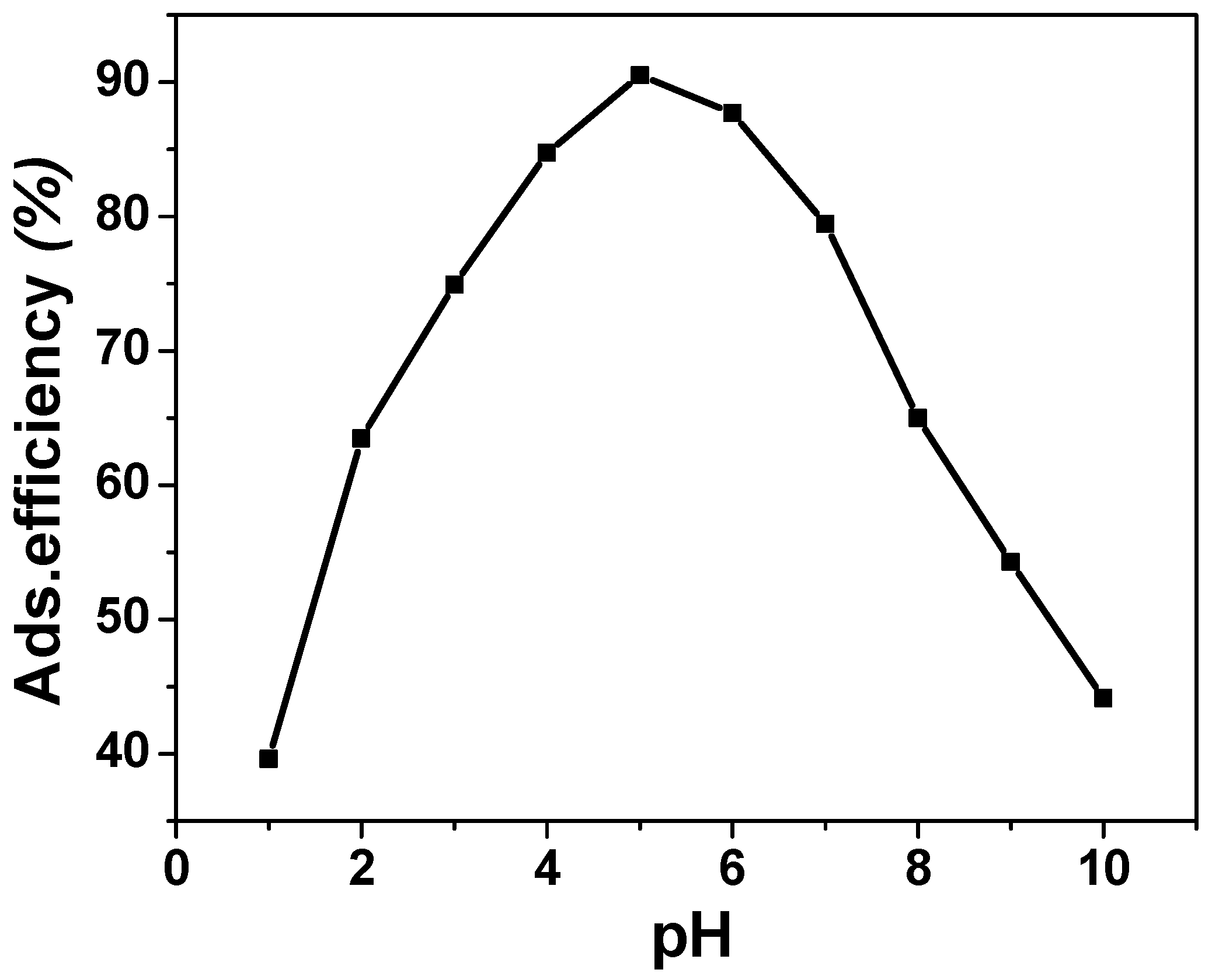

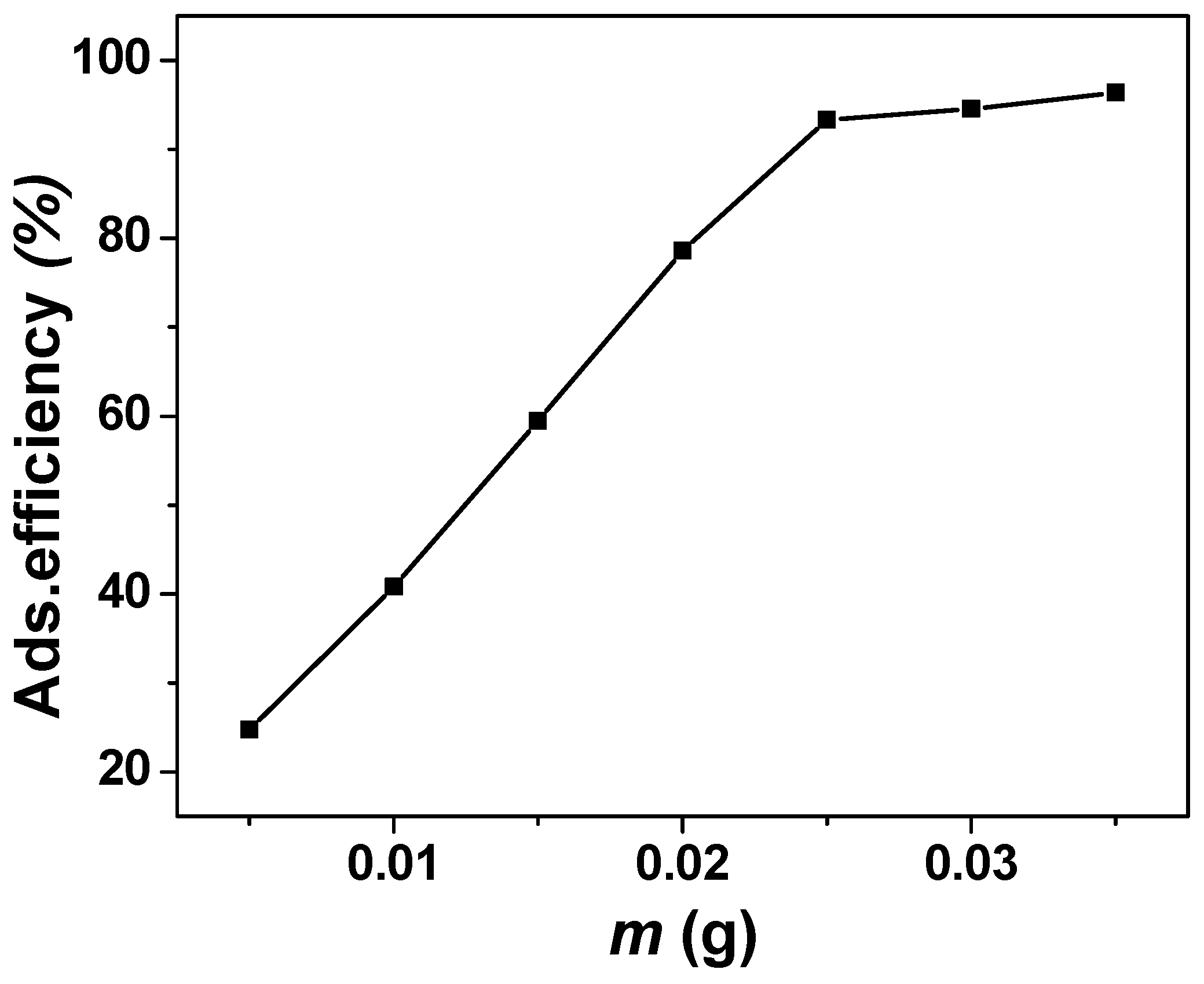
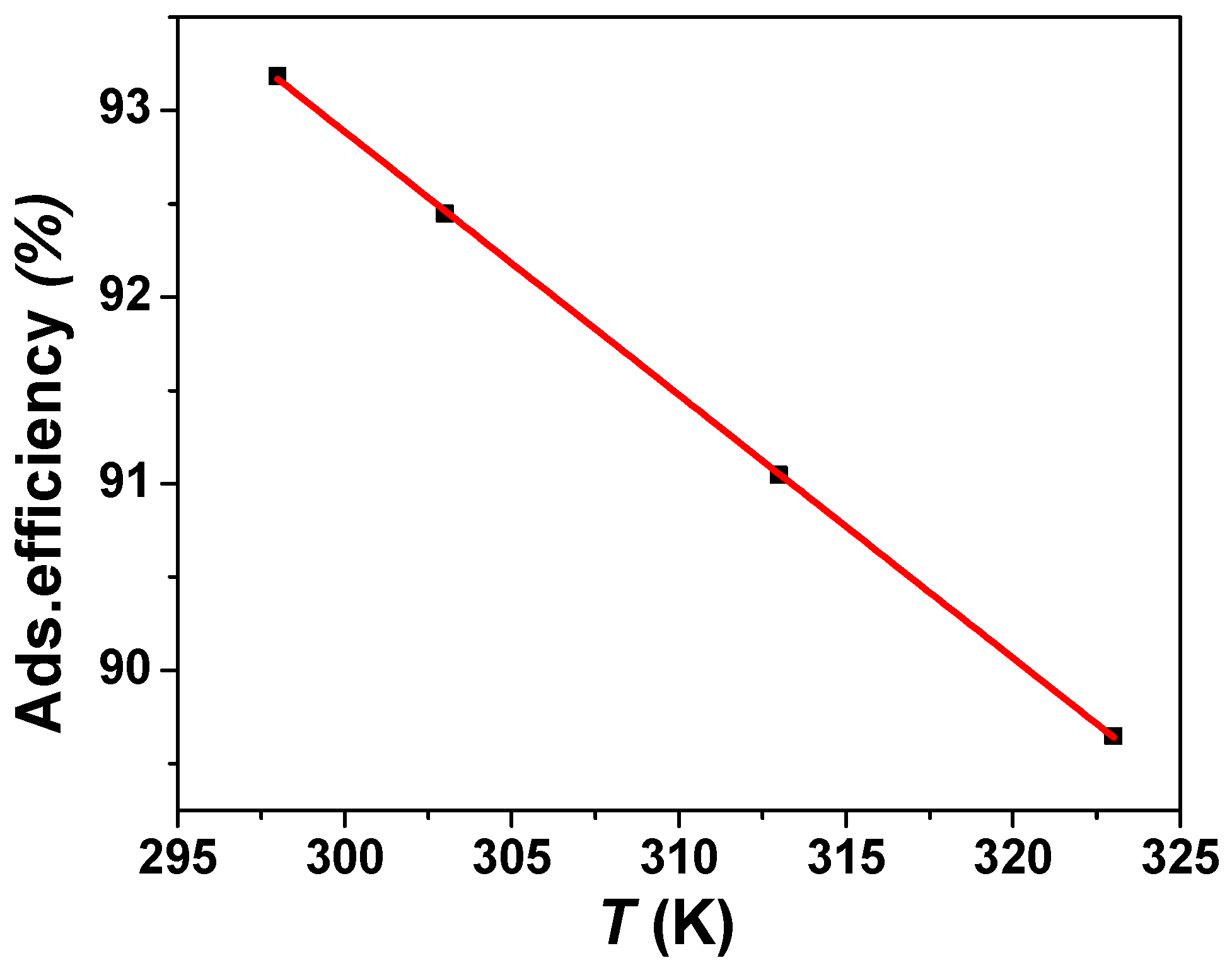
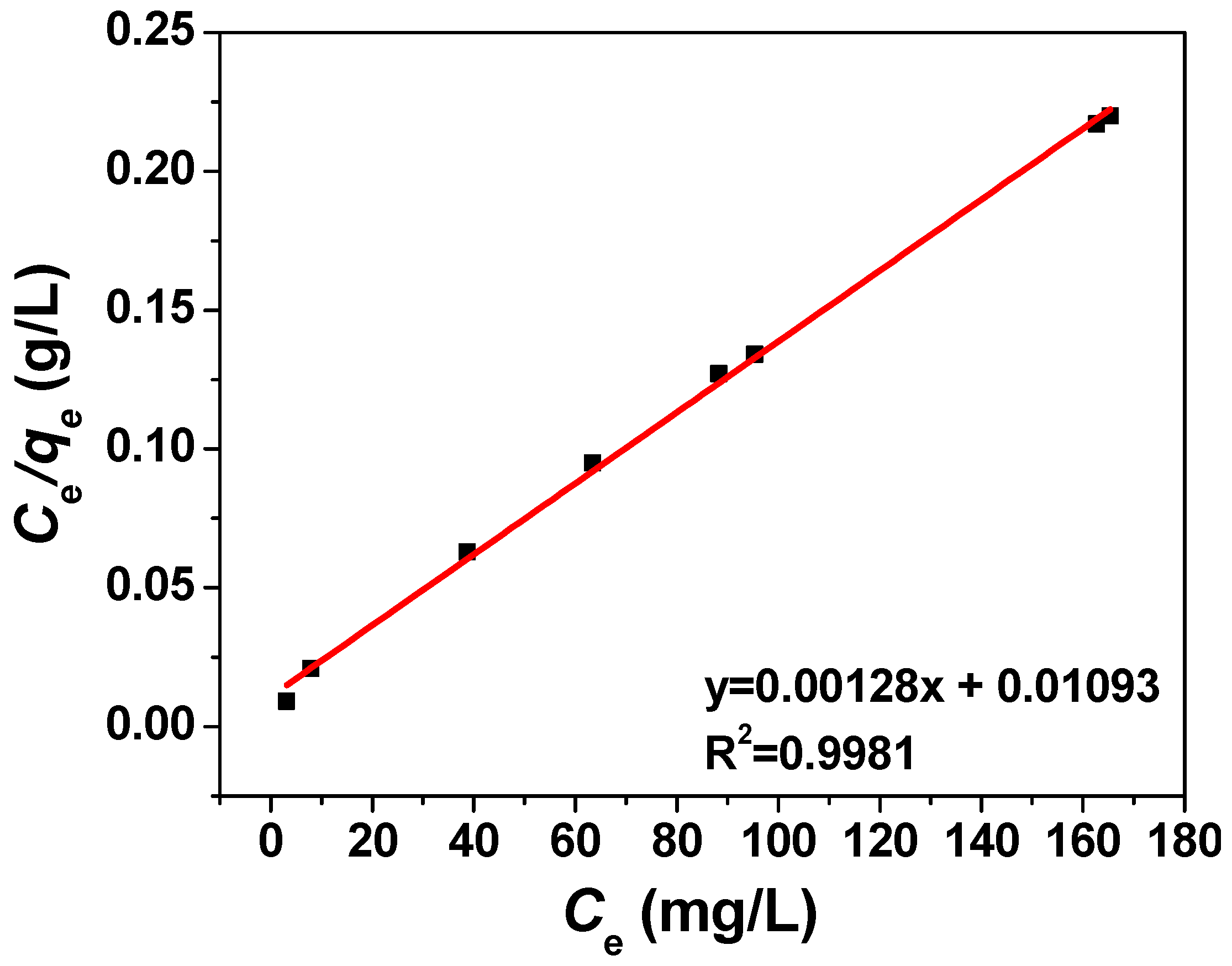

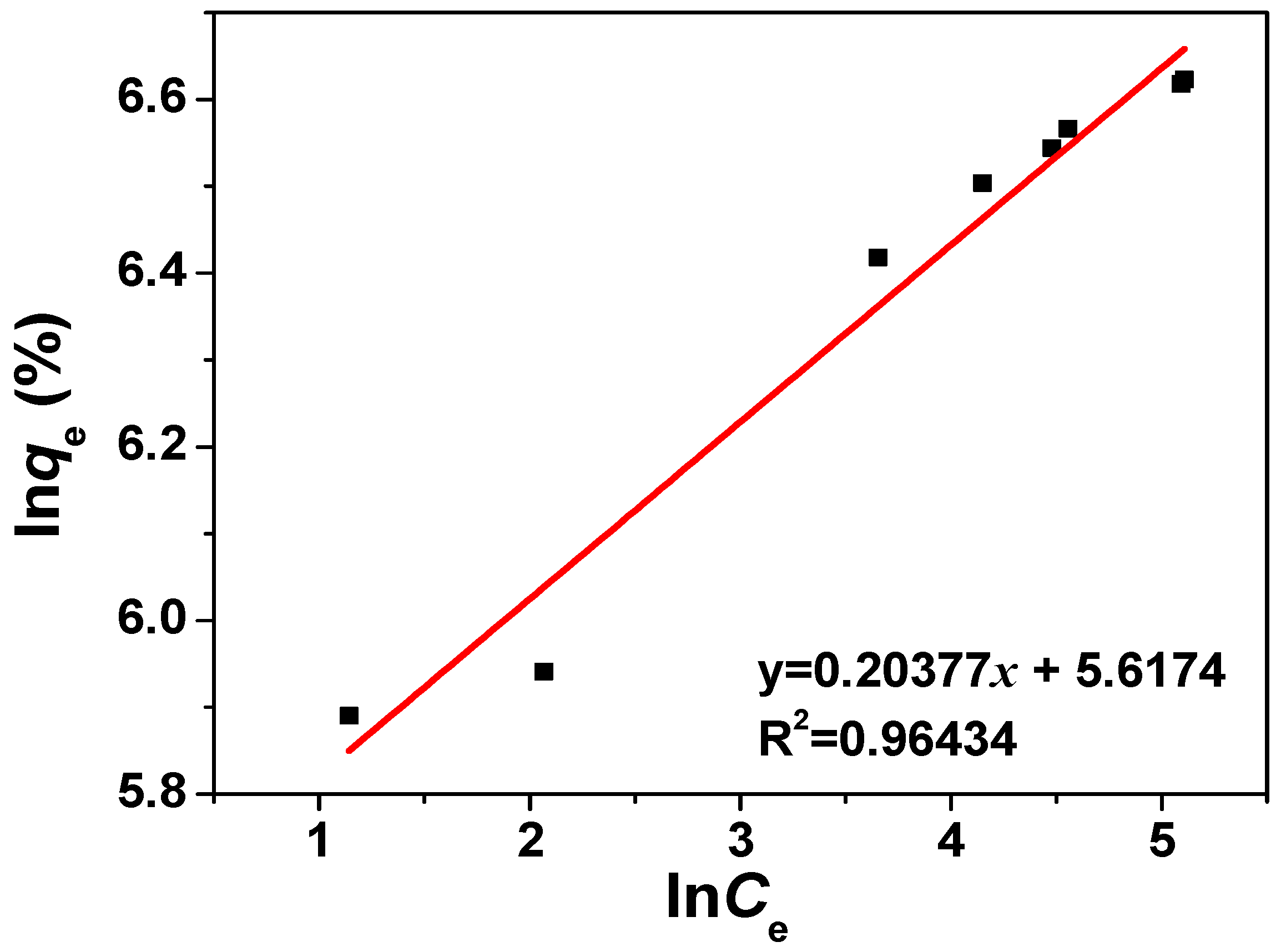
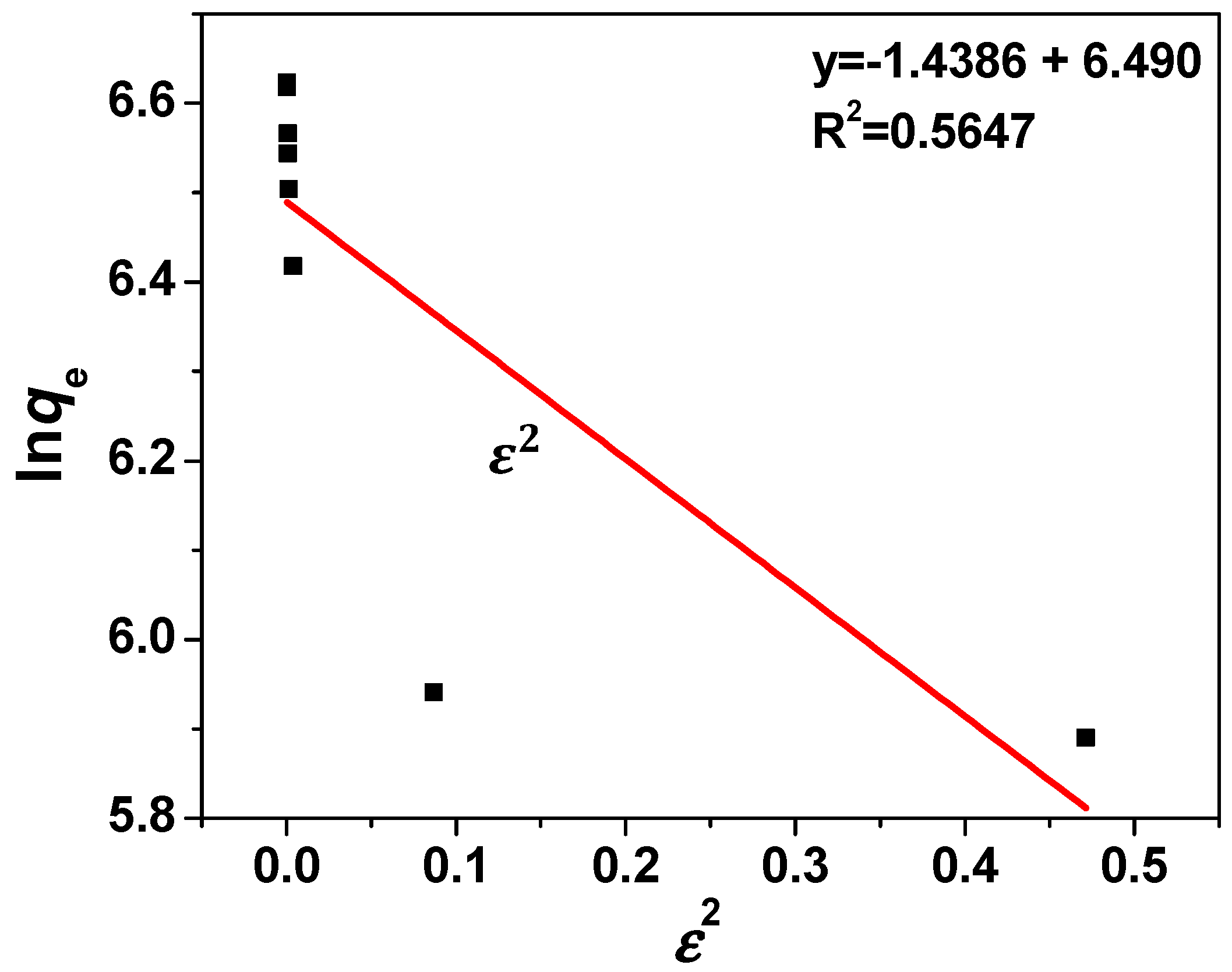


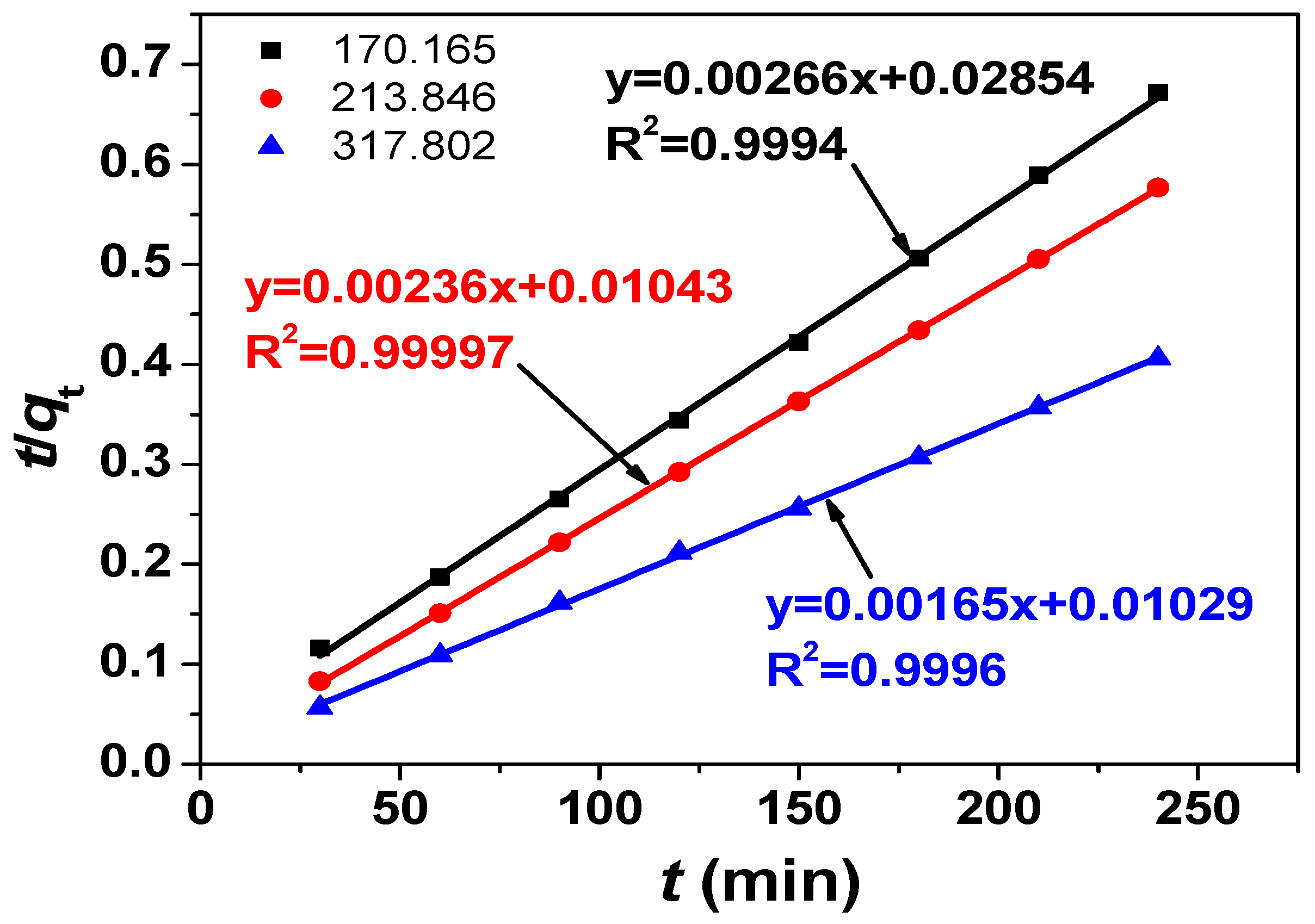
| Element | Theory | Result |
|---|---|---|
| Zn | 80.34 | 80.32 |
| O | 19.66 | 19.67 |
| Total | 100.00 | 99.99 |
| No. | Adsorbent | qmax (mg/g) | Ref. |
|---|---|---|---|
| 1 | ZnO | 168.4 | [27] |
| 2 | Zn-Al LDO (573 K, Curea ¼ 0.4 M) | 232.0 | [28] |
| 3 | Zn-Al LDH (Curea ¼ 0.4 M) | 76.1 | [28] |
| 4 | ZnO Nanorods | 89.0 | [25] |
| 5 | SnO2 | 21.5 | [29] |
| 6 | WO3 | 19.0 | [29] |
| 7 | Fe(III)–Cu(II) binary oxides | 35.2 | [30] |
| 8 | Silver nanoparticle-loaded activated carbon | 4.5 | [31] |
| 9 | Magnetite-enriched particles (MEP) | 6.4 | [32] |
| 10 | ZnO | 769.23 | Our work |
| Isothermal Line Model | Parameters | |
|---|---|---|
| Langmuir | KL (L/mg) | 0.12 |
| qmax (mg/g) | 769.23 | |
| R2 | 0.99 | |
| Freundlich | KF (mg/g)(mg/L)1/n | 275.145 |
| N | 4.907 | |
| R2 | 0.97 | |
| Tempkin | KT | 6.887 |
| bT (kJ/mol) | 0.023 | |
| R2 | 0.9694 | |
| Dubinin–Radushkevich | qmax (mg/g) | 658.392 |
| (mol2/J2) | −1.439 | |
| R2 | 0.6276 | |
| E (kJ/mol) | 0.5894 | |
| Concentration (mg/L) | qe.exp (mg/g) | qe.cal (mg/g) | k1 (min−1) | R2 |
|---|---|---|---|---|
| Pseudo-first-order model | ||||
| 51.765 | 29.984 | 20.289 | 0.0589 | 0.872 |
| 71.350 | 39.436 | 30.033 | 0.0564 | 0.927 |
| 103.546 | 53.768 | 42.897 | 0.0640 | 0.960 |
| Pseudo-second-order model | ||||
| Concentration (mg/L) | qe.exp (mg/g) | qe.cal (mg/g) | k2 (g/mg.min) | R2 |
| 51.765 | 30.073 | 30.959 | 0.015 | 0.999 |
| 71.350 | 39.436 | 40.650 | 0.010 | 0.999 |
| 103.546 | 53.590 | 54.645 | 0.010 | 0.999 |
| Concentration (mg/L) | h | k2 (g/mg.min) | Ea (kJ/mol) |
|---|---|---|---|
| 170.165 | 26.150 | 2.074 × 10−4 | 23.394 |
| 213.846 | 34.519 | 2.198 × 10−4 | 23.938 |
| 317.802 | 52.322 | 2.238 × 10−4 | 24.923 |
| T (K) | ∆G0 (kJ/mol) | ∆H0 (kJ/mol) | ∆S0 (kJ/mol.K) |
|---|---|---|---|
| 298 | −8.73 | −14.55 | −0.02 |
| 303 | −8.63 | ||
| 313 | −8.44 | ||
| 323 | −8.24 |
Publisher’s Note: MDPI stays neutral with regard to jurisdictional claims in published maps and institutional affiliations. |
© 2020 by the authors. Licensee MDPI, Basel, Switzerland. This article is an open access article distributed under the terms and conditions of the Creative Commons Attribution (CC BY) license (http://creativecommons.org/licenses/by/4.0/).
Share and Cite
Do, T.H.; Nguyen, V.T.; Nguyen, Q.D.; Chu, M.N.; Ngo, T.C.Q.; Tan, L.V. Equilibrium, Kinetic and Thermodynamic Studies for Sorption of Phosphate from Aqueous Solutions Using ZnO Nanoparticles. Processes 2020, 8, 1397. https://doi.org/10.3390/pr8111397
Do TH, Nguyen VT, Nguyen QD, Chu MN, Ngo TCQ, Tan LV. Equilibrium, Kinetic and Thermodynamic Studies for Sorption of Phosphate from Aqueous Solutions Using ZnO Nanoparticles. Processes. 2020; 8(11):1397. https://doi.org/10.3390/pr8111397
Chicago/Turabian StyleDo, Tra Huong, Van Tu Nguyen, Quoc Dung Nguyen, Manh Nhuong Chu, Thi Cam Quyen Ngo, and Lam Van Tan. 2020. "Equilibrium, Kinetic and Thermodynamic Studies for Sorption of Phosphate from Aqueous Solutions Using ZnO Nanoparticles" Processes 8, no. 11: 1397. https://doi.org/10.3390/pr8111397
APA StyleDo, T. H., Nguyen, V. T., Nguyen, Q. D., Chu, M. N., Ngo, T. C. Q., & Tan, L. V. (2020). Equilibrium, Kinetic and Thermodynamic Studies for Sorption of Phosphate from Aqueous Solutions Using ZnO Nanoparticles. Processes, 8(11), 1397. https://doi.org/10.3390/pr8111397





